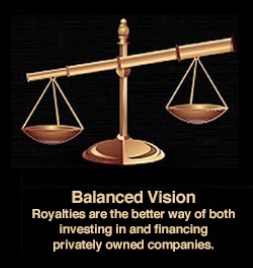
The use of equity related securities, such as stock or debt instruments, creates an adversarial relationship between investors and company founders since the goals of the parties differ. Investors in stocks seek the largest percentage of company ownership, for the least amount of funding, and debt holders are primarily focused on risk and securing the maximum amount of residual value when things go wrong.
Revenue royalties (royalties) are a percentage of a company’s defined (source and location) revenues. Elements of royalty agreements focus on the following:
Amount to be invested, which can be fixed or staged, based on corporate performance. There can also be metrics added which are related to the size of local payroll or other factors important to the investor.
Duration of payment period, which can be flexible, with the inclusion of an Issuer’s Right of Redemption, terminating the royalty upon the payment of an agreed cumulative amount, including all royalty payments made, within an agreed period. The agreed amount we recommend is a multiple of the investor’s cost, resulting in a superior and alternative risk-balanced investment return.
Royalty rate, which can be modified based on performance, and is projected to return an Internal Rate of Return (IRR) satisfactory to the investor. We have developed remedies for cases where the revenues are less than those initially projected. Some of our approaches to structuring royalties have been U.S. patented, and all are subject to negotiation between the investor and royalty issuing company. We can assist both investors and issuers in preparing for negotiations.
As with all investments, portfolio diversification is recommended. The stage of development, objective of companies, and the identification of companies’ anticipated customers can be reflected in allocations.
Investors who have among their primary concerns the sustainability of investee companies must assess the possibility that the magnitude and projected timing of revenues will vary from the negotiated minimums. This requires a study of the company’s resources, difficulty of product creation and anticipated customer demand at the estimated offering price of the product or service. If the projections of revenue commencement are accurate and positive, the issue of sustainability can then be addressed. A failure to achieve the expected revenues within an agreed period can result in a change in the agreed terms of the royalty regarding payment period, royalty rate and investor protections. It is also possible that royalty issuing companies can be rewarded in certain of the terms if the commencement of defined revenues is earlier than predicted.
It is important to understand that royalty payments made by royalty issuing companies are federal income tax deductible, whereas debt repayment is not. Royalty payments received by investors are federal income tax free until the investor has received royalty payments equaling their cost of the royalty and are treated as ordinary income thereafter.
Royalties allow investors to be well rewarded, with royalty payments made upon the royalty issuer’s receipt of revenue, and company founders can retain all of their ownership in their company, which is of enormous benefit to them if the company succeeds. The community wins by increasing employment of residents, and in the case of technology companies society can be the greatest beneficiary of the company’s success.
We recommend that a representative of the royalty investor be invited to attend, as an observer, all royalty issuing company board meetings and receive agreed company data, at least until cumulative royalty payments reach an agreed level.
Our role is in the professional recommending of royalty structures and terms, not in the investor’s portfolio management or investment selection.
Arthur Lipper, Chairman arthurlipper@gmail.com
British Far East Holdings Ltd.
